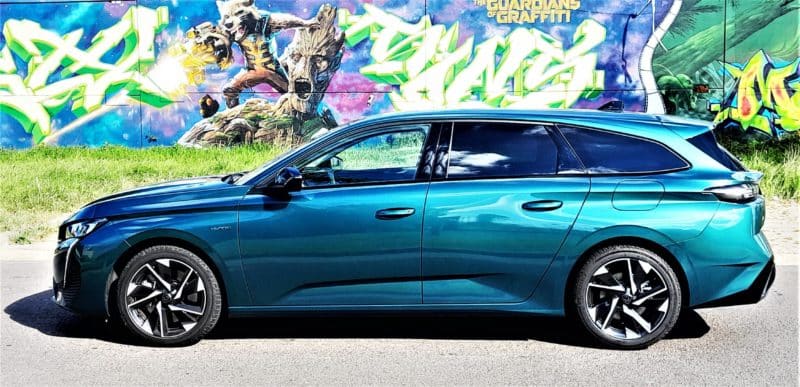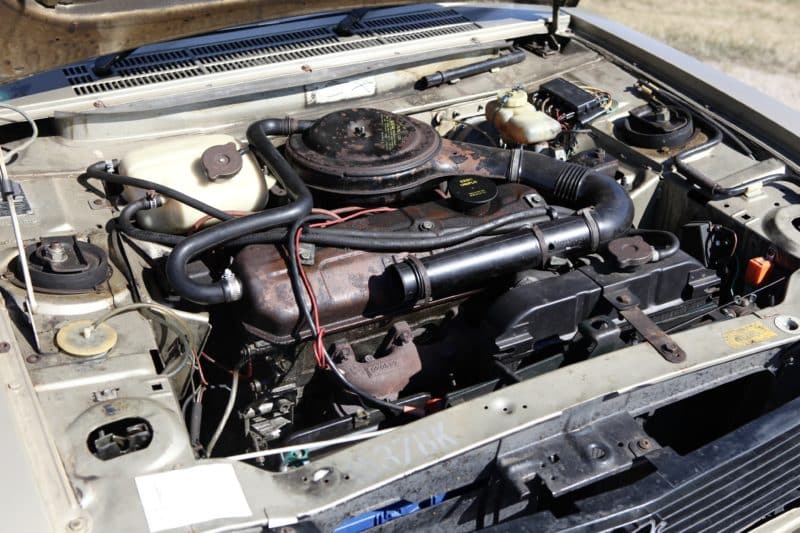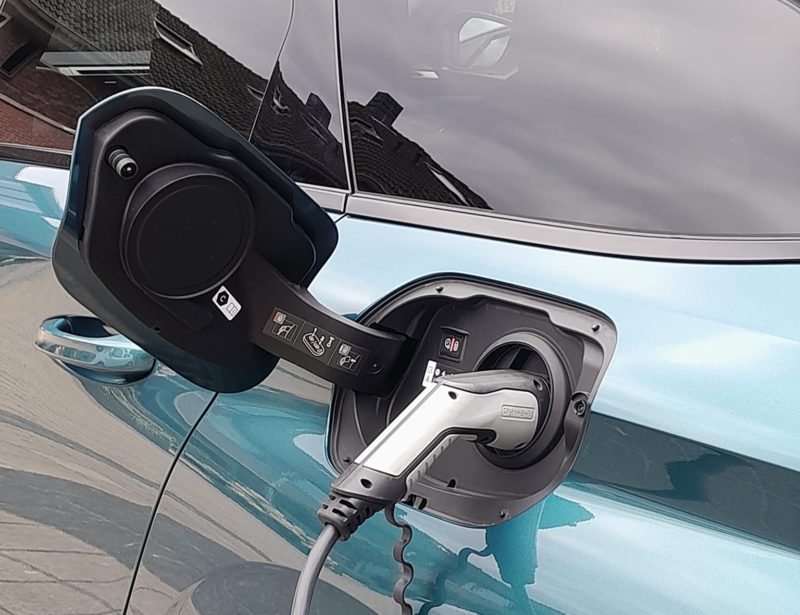For two weeks we have the Peugeot 308 SW Allure Pack Business Hybrid 180. We put this one on a beautiful Saturday Plug-in hybrid opposite one of his ancestors: the Peugeot 304 Break SL of Bert Hoekman and Ulko Gosma. You will soon read a lot more about the classic Peugeot and the special stories behind it in our magazine. But now we're traveling through time. And in two companies we are looking for the historic brand values, to which Peugeot attaches so much value. Next week you will read a driving impression of both Peugeots. Last week you read part one; now you are reading part two, the final piece in which we discuss the driving characteristics.
To start with the performance potential: the comparison between the old-timer and the newcomer is actually flawed. The 304 Break SL has the 1290 cc engine with 65 DIN hp on board. The new Peugeot 308 SW Hybrid has a system power of 180 DIN hp. The powertrain consists of the EAT-8 automatic transmission, the 1598 cc PureTech fuel engine (with turbo) and the electric motor powered by the 12,4 kW battery. And you can choose from three driving modes: Sport, Hybrid and Electric. Whichever you choose: the Peugeot accelerates at lightning speed and offers a wonderful intermediate acceleration. Initially we try that, of course, but we let that acceleration party go quickly. And at the stated top speed of 225 kilometers we are not even close. We could have moved to Germany for that, but that need quickly disappears like snow in the sun.
Efficient mindset
There's a reason for that: the mindset. It will be a sport to do as long as possible with a fully charged battery and to keep the number of emission-free kilometers as high as possible. When you carefully with the accelerator, you will also see that the battery is being recharged a bit. It is becoming a sport to use the fuel and petrol capacity as efficiently as possible at normal speeds. The specified 56 electric kilometers (in full electric mode) are absolutely achievable (especially during hot days). And in the hybrid mode you also reach far. We covered the distance Leeuwarden-Amsterdam at a maximum speed of 100 kilometers per hour with an average consumption of 1 in 28. The battery pack held charge until the end of the journey. Speaking of which: with the 7.4 KW On Board Charger (option, not mounted on this car) you can recharge the battery pack in just over two hours, without the option it takes four hours to fully charge an empty battery. The charging process can be followed via the My Peugeot App. Totally hip, all the way now.
Intrusive driving assistants, sport mode not nice
In the hybrid and electric modes, the Peugeot drives fine, moreover, the transition from electric to petrol vice versa is really smooth. You don't notice it. Within the mentioned driving modes, the self-learning EAT8 automatic transmission is well mannered, especially during quietly driven kilometers. It is best to omit the sports mode in all cases. The automatic transmission then folds in properly, the shift paths are too long. There is something less appealing. The Pack Business version has two safety packs on board. They are directive and far too dominant, they really infringe the driving pleasure with their brusque intervention. On the other hand, the blind spot detection works really excellent, and it makes inserting and overtaking easier. The 360 degree view and the reversing camera also work fine (both additionally mounted on the test car).
Great chassis
Peugeot has an excellent reputation in terms of chassis technology. Once again, the technicians - with the help of current group member Opel - delivered an excellent performance in this area. They also tuned the chassis of the 308 SW Hybrid to the substantial car weight. That is more than 300 kilos higher than with the regular fuel versions (ie without battery pack). As mentioned, the engineers do an excellent job. With the driving assistants switched off, the comfortably dynamic character emerges beautifully. Strictly speaking, the 308 SW is very reminiscent of Peugeots' D-segment models of the past, and of the current 508. The tuning is beautifully done, the driving dynamics and the comfortable character are completely balanced. However, the almost 1650 kilo heavy Peugeot is quite understeered. But across the board you keep it out for a long time, the Peugeot 308 SW is (certainly without safety packs) a very nice and comfortable travel car. And that is not least due to the excellent furniture and all (personally adjustable) digital conveniences on board. The beautiful design of the interior enhances the image of a pleasant trip.
Excellent comfort, beautifully tuned chassis at 304 Break SL
All the widgets, security systems and gadgets of today are of course not in the old 304 Break SL. He comes from a really different time. But the excellent and quite comfortable driving characteristics of the classic are still very appealing today. During a ride through Gaasterland we notice it in the classic by Bert and Ulko. The chassis (from mid 1977 with the new McPherson construction at the front) provides a comfortable center of gravity, but the spring travel and damping are beautifully coordinated. It never gets soft, but the chassis characteristics are extremely comfortable. This is aided by the excellently seated furniture, which is pleasantly supported and placed higher than in the modern successor. Point of criticism: the headrests on the front seats are a bit low. The freedom of movement of the 304 Break is fine for each other. Let it be said: in this classic and finely finished Peugeot you just keep it out for a long time. In that sense, the 304 had a reputation to uphold as an excellent travel and family car.
Nice engine, lovely steering wheel
As mentioned, the 304 Break SL is blessed with the fine XL5 engine with one carburettor and 1290 cc. The smooth power source enables the classic Peugeot to accelerate reasonably smoothly. The gears also flow nicely into each other. The combination means that, in a relative sense, there is quite a bit of spice in this luxurious 304 Break version. In part one of the comparison between the nestor and the benjamin, we already mentioned the arrangement of various controls. The layout is idiosyncratic, but you can find a way around it. You certainly quickly get used to the interplay between the steering gear, the gearbox and the (mechanically working) clutch. The control circuit works lightly, with long ranges and with a lot of feeling. The brakes are excellent for their task, and the steering is largely neutral. Not to mention, the excellent all-round visibility in the 304 Break SL is a wonderful passive safety feature. You never lose sight of what is happening around you. Very pleasant.
Peugeot individuality in its own way
The 304 is instantly recognizable as a genuine Peugeot in all respects, with an understated individualistic design, deviant ergonomics and wonderful driving characteristics. In some respects, this also applies to the stretched and low-drawn 308 SW, which, especially without driving safety systems enabled, transfers the characteristic Peugeot driving character to you in a recognizable way. If the safety systems are not installed or the technicians manage to refine them, Peugeot fans who are looking for a uniquely designed station within the c-segment cannot ignore the 308 SW. As they used to be able to avoid the 304 Break in this class. Because both cars offer individuality in their own way and a design philosophy that fits so well with the Peugeot brand name. Although this is even more apparent in the classic and extremely balanced Peugeot 304. Fair is fair.
Part one of this diptych is about the design of the 304 Break SL and the 308 SW.
Photos: Bart Spijker
Many thanks to Ellis Blase of Peugeot Nederland/Stellantis and to Bert Hoekman and Ulko Gosma, owners of the Peugeot 304 Break SL













Ms economical, but there is and will never come a skoda with the charm of an Italian or French automobile!
I also had a 1980 SW around 304, this was a diesel. The suppleness of these was not excellent and it was impossible to burn forward. Never had a Peugeot after that.
1:28, as a diesel driver, I actually disappoint for such a petrol hybrid. I drive an Octavia diesel (with ad-blue) over a long period of time and rides of an average of 100km, 1:35 (yes, 35 km per litre). Automatic and take it easy, max 100 and sometimes a bit behind a truck, but otherwise without much effort. Just as it is a sport to get as fast as possible on a battery, it is a sport for me to stay above 35 km on the long average.